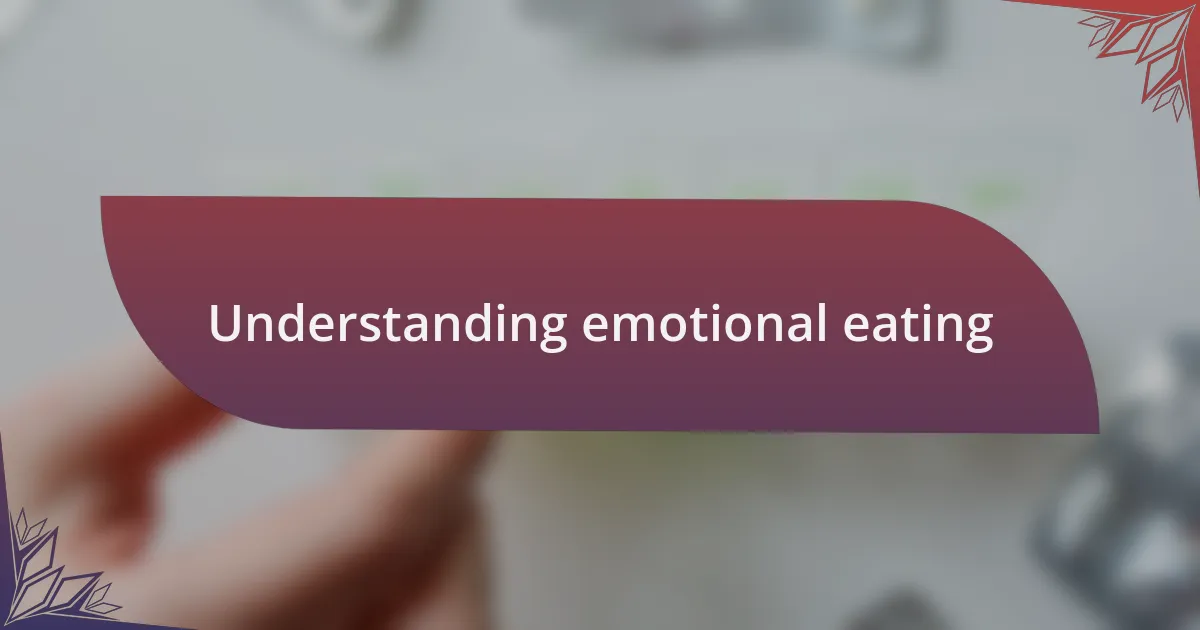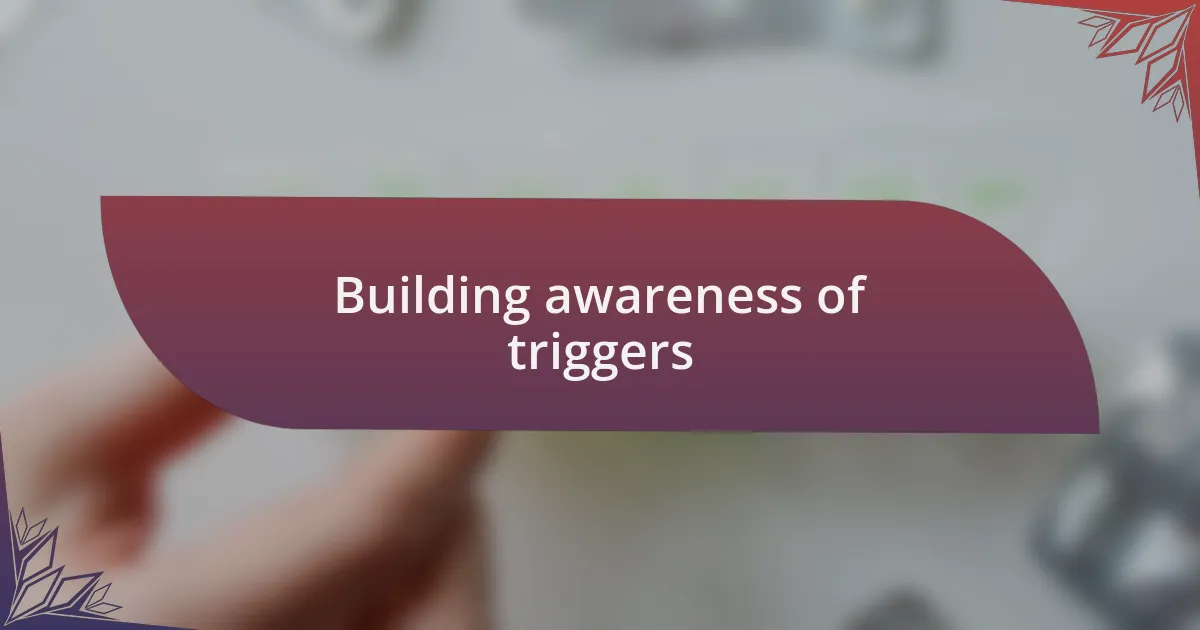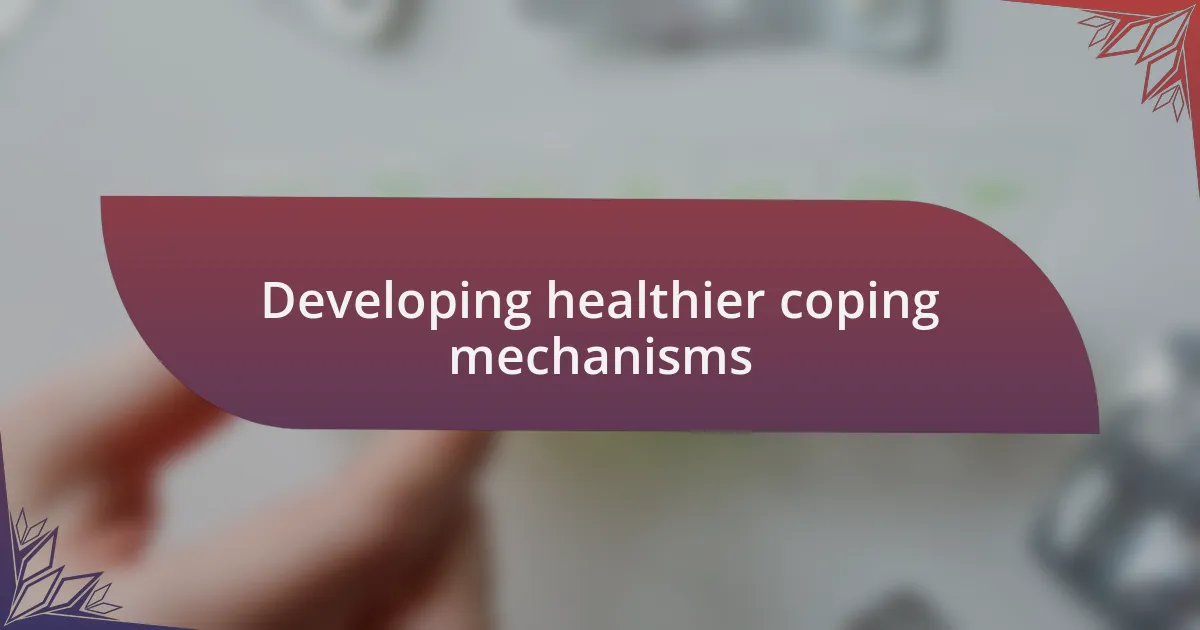Key takeaways:
- Emotional eating is driven by feelings rather than hunger, often linked to stress, anxiety, or nostalgia.
- It can lead to negative physical health consequences and a turbulent relationship with one’s self-image.
- Developing awareness of triggers and practicing mindful eating are key strategies for managing cravings.
- Utilizing healthier coping mechanisms, such as physical activity and deep breathing, can reduce reliance on food for emotional comfort.

Understanding emotional eating
Emotional eating is a complex behavior fueled by feelings rather than hunger. I remember a time when stressful work deadlines led me to snack mindlessly on chips, despite not being physically hungry. Have you ever found yourself reaching for comfort food after a long day, even when your stomach isn’t growling?
Often, emotional eating can stem from a desire to cope with stress, anxiety, loneliness, or even boredom. It’s fascinating how certain foods can evoke memories or feelings of comfort; for instance, my fondness for chocolate cake links back to childhood celebrations. This connection begs the question: how often do we turn to familiar flavors for emotional solace instead of reflecting on what truly needs our attention?
Understanding emotional eating involves recognizing these triggers and the emotional state behind our food choices. I’ve found that simply pausing before indulging can reveal whether I’m truly hungry or just looking for a distraction. It’s a small but powerful practice that opens the door to deeper awareness of our behaviors.

Impact of emotional eating
Emotional eating has far-reaching consequences that extend beyond mere weight gain. I recall a period in my life where I relied on food to soothe my feelings after a breakup, only to find that the temporary relief was quickly replaced by guilt and sadness. How often do we compromise our feelings with sweets, thinking they’ll fill an emotional void but instead leaving us feeling more depleted?
The impact of emotional eating can also manifest in physical health issues, such as increased risk of obesity and related conditions like heart disease. I once had a friend who managed her anxiety through constant snacking, which ultimately led to health problems and a cycle of shame. That experience taught me the importance of addressing not just what we eat, but why we eat it.
Emotionally, the pull of food can create a turbulent relationship with one’s body and self-image. I’ve seen how fluctuating weight due to emotional eating can lead to a negative self-perception, driving a wedge between how we view ourselves and our true worth. Isn’t it interesting how a bag of chips can start as a comfort and end as a complex emotional struggle?

Strategies for managing cravings
Managing cravings can feel like an uphill battle, but I’ve found that developing awareness of triggers is essential. For instance, I once noticed that stress at work led me to crave salty snacks. By paying attention to these patterns, I learned to substitute that urge with a quick walk or a few minutes of meditation. How often do we find ourselves reaching for foods without even realizing why?
I’ve also discovered that keeping healthy snacks on hand truly makes a difference. When I would have a craving in the afternoon, instead of reaching for cookies, I began munching on nuts or sliced veggies. Those small changes not only satisfied my snacking desire but also made me feel better about my choices. Isn’t it interesting how a simple swap can turn a moment of weakness into a step toward healthier habits?
Another strategy that has proven effective for me is practicing mindful eating. Taking the time to savor each bite allows me to enjoy food more fully and recognize when I’m genuinely hungry versus eating out of boredom or stress. The last time I indulged in chocolate, I focused on the texture and flavor rather than mindlessly consuming it. This practice not only reduces cravings but fosters a healthier connection with food. What has your experience been with savoring meals?

Building awareness of triggers
Building awareness of triggers is a powerful first step in navigating emotional eating. I remember a time at a family gathering when I realized that being surrounded by certain people made me reach for dessert, even when I wasn’t hungry. It dawned on me that these social settings often heightened my desire to snack. By identifying this trigger, I can now prepare mentally for such events, often choosing to engage in conversations instead of indulging in treats.
Another significant moment occurred during a particularly stressful week at work. I noticed my inclination to grab a sugary drink each afternoon. Rather than merely analyzing the craving, I took the time to reflect on the emotions driving it—stress and fatigue. This awareness allowed me to seek healthier coping mechanisms, such as drinking herbal tea or going for an invigorating walk instead. It’s amazing how understanding our emotions can transform our cravings. Have you ever thought about what lies behind your food choices?
Moreover, I find it helpful to journal about my eating patterns and the feelings attached to them. When I pen down my experiences, it becomes clear which situations trigger my desire to eat emotionally. Just last month, I wrote about a day when loneliness led me to munch on chips as I binge-watched my favorite show. Recognizing that connection allowed me to consider other activities to fill the void, like picking up a new hobby or reaching out to a friend. This process made me realize that acknowledging my triggers not only helps in managing cravings but also fosters a deeper understanding of myself. What do your food-related emotions reveal about your needs?

Developing healthier coping mechanisms
Finding healthier coping mechanisms doesn’t happen overnight, but it’s a journey worth embarking on. For instance, during tough times, I often turned to baking as a way to soothe my emotions. What I realized, though, was that while mixing ingredients was therapeutic, overindulging in the treats often led to guilt. Now, I focus on cooking as a creative outlet without losing track of my eating habits. Have you ever enjoyed a hobby so much that it distracted you from emotional eating?
Whenever I feel the urge to snack mindlessly, I’ve adopted the practice of deep breathing. Initially, it felt strange to pause and inhale deeply when cravings hit, but it quickly became a game-changer. Last week, I paused before reaching for a cookie and spent a minute breathing and reflecting. I found that my cravings subsided and I felt more grounded. Isn’t it fascinating how something so simple can shift our perspective and influence our choices?
Physical activity has also played a significant role in my coping strategy. I never used to see walking as more than just a way to get from point A to B. However, during a recent walk, I found clarity while tackling my stress rather than eating through it. It became a pivotal moment where I realized movement could be a mighty ally, transforming anxious energy into zest for healthier living. What activities make you feel invigorated and less likely to turn to food for comfort?

Resources for support and guidance
There are plenty of resources available to help navigate emotional eating effectively. One that I found particularly helpful was joining a support group. Sharing experiences with others who understand the struggles can be immensely comforting. Have you ever felt that sense of relief when you realize you’re not alone in your journey?
In addition to support groups, individual counseling can provide tailored strategies to address emotional eating. From my own experience, working with a therapist offered insights into my triggers and allowed me to explore deeper emotional issues at play. It was like having a guiding hand, helping me navigate the complexities of my relationship with food. Isn’t it interesting how a professional perspective can shift our understanding?
Finally, I’ve discovered numerous online resources, including articles and webinars that delve into emotional eating. One resource I wish I had earlier was a podcast focused on mindfulness and food relationships. Listening to others share their stories and techniques felt like I had a friend whispering into my ear, reminding me of more mindful choices. What online resources have you explored that might lighten the emotional load of eating?